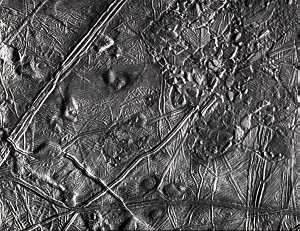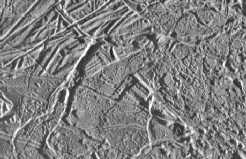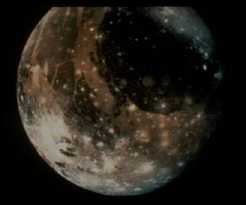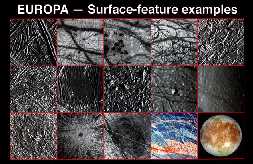This picture shows many photos of Europa and its surface taken during the Galileo mission. There are many interesting surface features on this moon.
Click on image for full size
NASA
Surface of Europa
Many exciting discoveries were made about Europa during the
Galileo mission. The surface of Europa is unusual, even for an icy moon. It appears that the surface is pretty new, rather than being ancient. Instead of craters, there appear to be strange cracks that reach for many kilometers over the surface of the moon. Closeup images of the surface suggest that there might be an
ocean under the icy surface.
The surface of Europa also shows a form of volcanism found on Earth as well as on icy moons called
icy-volcanism. Other features include changes in the icy crust common to places where volcanism is found. The surface also shows evidence of
new molecules that form because of
radiation in the environment!
All this evidence for geologic activity points to a heat source in the interior of Europa.
You might also be interested in:

Galileo was a spacecraft that orbited Jupiter for eight years. It made many discoveries about Jupiter and its moons. Galileo was launched in 1989, and reached Jupiter in 1995. The spacecraft had two parts.
...more
The surface of Europa shows many signs of that there may be an ocean hidden underneath: * flooded areas * 'freckles' * 'rafting' * 'mushy' craters, and * regions of spreading. These clues make it pretty
...more
This is an example of the surface of Europa. The surface may be flooded by fresh water from underground, which freezes when it touches the surface. The edges of the flow are rounded, like a puddle of water
...more
Europa was first discovered by Galileo in 1610, making it one of the Galilean Satellites. It is Jupiter's 4th largest moon, 670,900 km ( miles) from Jupiter. Europa's diameter is about half the distance
...more
The surface of Ganymede is halfway between Callisto and Europa. There are portions of the surface of Ganymede that have many craters, like Callisto and there are portions which are relatively new, and
...more
The icy moons have no atmosphere. The reason they have no atmosphere is because they do not have enough gravity. The smaller the body is the lower its gravity, so moons have much less gravity than a planet
...more
Amalthea was discovered by E Barnard in 1872. Of the 17 moons it is the 3rd closest to Jupiter. Amalthea is about the size of a county or small state. Amalthea is named after the goat in Greek mythology
...more















